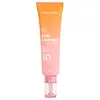What's inside
What's inside
 Key Ingredients
Key Ingredients

 Benefits
Benefits

 Concerns
Concerns

No concerns
 Ingredients Side-by-side
Ingredients Side-by-side

Water
Skin ConditioningButylene Glycol
HumectantButyl Methoxydibenzoylmethane
UV AbsorberEthylhexyl Methoxycinnamate
UV AbsorberGlycerin
HumectantPhenylbenzimidazole Sulfonic Acid
UV AbsorberOctocrylene
UV AbsorberPolyacrylate Crosspolymer-11
Emulsion StabilisingBetaine
HumectantCentella Asiatica Extract
CleansingTriethanolamine
BufferingSilica
AbrasivePhenoxyethanol
PreservativeCamellia Sinensis Leaf Extract
AntimicrobialLecithin
EmollientChlorphenesin
AntimicrobialTriethylene Glycol
MaskingMethicone
EmollientWater, Butylene Glycol, Butyl Methoxydibenzoylmethane, Ethylhexyl Methoxycinnamate, Glycerin, Phenylbenzimidazole Sulfonic Acid, Octocrylene, Polyacrylate Crosspolymer-11, Betaine, Centella Asiatica Extract, Triethanolamine, Silica, Phenoxyethanol, Camellia Sinensis Leaf Extract, Lecithin, Chlorphenesin, Triethylene Glycol, Methicone
Water
Skin ConditioningZinc Oxide
Cosmetic ColorantTitanium Dioxide
Cosmetic ColorantGlycerin
HumectantHydroxyethyl Acrylate/Sodium Acryloyldimethyl Taurate Copolymer
Emulsion StabilisingAloe Ferox Leaf Juice Extract
Skin ConditioningAcrylates/Polytrimethylsiloxymethacrylate Copolymer
Skin ConditioningPolyquaternium-7
Propanediol
SolventIsohexadecane
EmollientSodium Hyaluronate
HumectantCeramide 3
Skin ConditioningChlorphenesin
AntimicrobialPolysorbate 60
EmulsifyingAcrylates Crosspolymer
AbsorbentPhenoxyethanol
PreservativeAllantoin
Skin ConditioningPanthenol
Skin ConditioningLaureth-1 Phosphate
Ectoin
Skin ConditioningPotassium Hydroxide
BufferingWater, Zinc Oxide, Titanium Dioxide, Glycerin, Hydroxyethyl Acrylate/Sodium Acryloyldimethyl Taurate Copolymer, Aloe Ferox Leaf Juice Extract, Acrylates/Polytrimethylsiloxymethacrylate Copolymer, Polyquaternium-7, Propanediol, Isohexadecane, Sodium Hyaluronate, Ceramide 3, Chlorphenesin, Polysorbate 60, Acrylates Crosspolymer, Phenoxyethanol, Allantoin, Panthenol, Laureth-1 Phosphate, Ectoin, Potassium Hydroxide
 Reviews
Reviews

Ingredients Explained
These ingredients are found in both products.
Ingredients higher up in an ingredient list are typically present in a larger amount.
Chlorphenesin is a synthetic preservative. It helps protect a product against bacteria in order to extend shelf life. In most cases, Chlorphenesin is paired with other preservatives such as phenoxyethanol and caprylyl glycol.
Chlorphenesin is a biocide. This means it is able to help fight the microorganisms on our skin. It is also able to fight odor-releasing bacteria.
Chlorphenesin is soluble in both water and glycerin.
Studies show Chlorphenesin is easily absorbed by our skin. You should speak with a skincare professional if you have concerns about using Chlorphenesin.
Learn more about ChlorphenesinGlycerin is already naturally found in your skin. It helps moisturize and protect your skin.
A study from 2016 found glycerin to be more effective as a humectant than AHAs and hyaluronic acid.
As a humectant, it helps the skin stay hydrated by pulling moisture to your skin. The low molecular weight of glycerin allows it to pull moisture into the deeper layers of your skin.
Hydrated skin improves your skin barrier; Your skin barrier helps protect against irritants and bacteria.
Glycerin has also been found to have antimicrobial and antiviral properties. Due to these properties, glycerin is often used in wound and burn treatments.
In cosmetics, glycerin is usually derived from plants such as soybean or palm. However, it can also be sourced from animals, such as tallow or animal fat.
This ingredient is organic, colorless, odorless, and non-toxic.
Glycerin is the name for this ingredient in American English. British English uses Glycerol/Glycerine.
Learn more about GlycerinPhenoxyethanol is a preservative that has germicide, antimicrobial, and aromatic properties. Studies show that phenoxyethanol can prevent microbial growth. By itself, it has a scent that is similar to that of a rose.
It's often used in formulations along with Caprylyl Glycol to preserve the shelf life of products.
Water. It's the most common cosmetic ingredient of all. You'll usually see it at the top of ingredient lists, meaning that it makes up the largest part of the product.
So why is it so popular? Water most often acts as a solvent - this means that it helps dissolve other ingredients into the formulation.
You'll also recognize water as that liquid we all need to stay alive. If you see this, drink a glass of water. Stay hydrated!
Learn more about Water